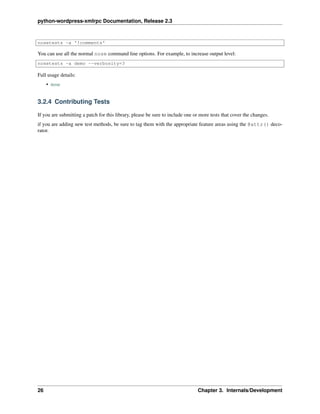Python wordpress-xmlrpc
- 3. Contents 1 Getting Started 3 1.1 Overview . . . . . . . . . . . . . . . . . . . . . . . . . . . . . . . . . . . . . . . . . . . . . . . . . 3 1.2 Examples . . . . . . . . . . . . . . . . . . . . . . . . . . . . . . . . . . . . . . . . . . . . . . . . . 4 2 Reference 11 2.1 Client . . . . . . . . . . . . . . . . . . . . . . . . . . . . . . . . . . . . . . . . . . . . . . . . . . . 11 2.2 WordPress Objects . . . . . . . . . . . . . . . . . . . . . . . . . . . . . . . . . . . . . . . . . . . . 12 2.3 Methods . . . . . . . . . . . . . . . . . . . . . . . . . . . . . . . . . . . . . . . . . . . . . . . . . 16 3 Internals/Development 23 3.1 History/CHANGELOG . . . . . . . . . . . . . . . . . . . . . . . . . . . . . . . . . . . . . . . . . 23 3.2 Testing . . . . . . . . . . . . . . . . . . . . . . . . . . . . . . . . . . . . . . . . . . . . . . . . . . 25 4 Indices and tables 27 Python Module Index 29 i
- 4. ii
- 5. python-wordpress-xmlrpc Documentation, Release 2.3 Python library to interface with a WordPress blog’s XML-RPC API. An implementation of the standard WordPress API methods is provided, but the library is designed for easy integration with custom XML-RPC API methods provided by plugins. A set of classes are provided that wrap the standard WordPress data types (e.g., Blog, Post, User). The provided method implementations return these objects when possible. Note: In Wordpress 3.5+, the XML-RPC API is enabled by default and cannot be disabled. In Wordpress 0.70-3.42, the XML-RPC API is disabled by default. To enable it, go to Settings->Writing->Remote Publishing and check the box for XML-RPC. Warning: python-wordpress-xmlrpc 2.0+ is not fully backwards-compatible with 1.x versions of the library. Contents 1
- 6. python-wordpress-xmlrpc Documentation, Release 2.3 2 Contents
- 7. CHAPTER 1 Getting Started 1.1 Overview 1.1.1 Installation 1. Verify you meet the following requirements: • WordPress 3.4+ OR WordPress 3.0-3.3 with the XML-RPC Modernization Plugin. • Python 2.6+ OR Python 3.x 2. Install from PyPI using easy_install python-wordpress-xmlrpc or pip install python-wordpress-xmlrpc. 1.1.2 Quick Start Create an instance of the Client class with the URL of the WordPress XML-RPC endpoint and user credentials. Then pass an XmlrpcMethod object into its call method to execute the remote call and return the result. >>> from wordpress_xmlrpc import Client, WordPressPost >>> from wordpress_xmlrpc.methods.posts import GetPosts, NewPost >>> from wordpress_xmlrpc.methods.users import GetUserInfo >>> wp = Client('http://mysite.wordpress.com/xmlrpc.php', 'username', 'password') >>> wp.call(GetPosts()) [<WordPressPost: hello-world (id=1)>] >>> wp.call(GetUserInfo()) <WordPressUser: max> >>> post = WordPressPost() >>> post.title = 'My new title' >>> post.content = 'This is the body of my new post.' >>> post.terms_names = { >>> 'post_tag': ['test', 'firstpost'], >>> 'category': ['Introductions', 'Tests'] >>> } >>> wp.call(NewPost(post)) 5 Notice that properties of WordPress objects are accessed directly, and not through the definition attribute defined in the source code. 3
- 8. python-wordpress-xmlrpc Documentation, Release 2.3 When a WordPress object is used as a method parameter, its struct parameter is automatically extracted for con- sumption by XML-RPC. However, if you use an object in a list or other embedded data structure used as a parameter, be sure to use obj.struct or else WordPress will not receive data in the format it expects. Custom XML-RPC Methods To interface with a non-standard XML-RPC method (such as one added by a plugin), you must sim- ply extend wordpress_xmlrpc.XmlrpcMethod or one of its subclasses (AnonymousMethod or AuthenticatedMethod). The XmlrpcMethod class provides a number of properties which you can override to modify the behavior of the method call. Sample class to call a custom method added by a ficticious plugin: from wordpress_xmlrpc import AuthenticatedMethod class MyCustomMethod(AuthenticatedMethod): method_name = 'custom.MyMethod' method_args = ('arg1', 'arg2') See Custom XML-RPC Methods for more details. 1.2 Examples 1.2.1 Working with Posts python-wordpress-xmlrpc supports all registered WordPress post types. Behind the scenes in WordPress, all post types are based on a single “post” database table, and all of the functionality is exposed through the posts methods in the XML-RPC API. For consistency, the same approach is adopted by python-wordpress-xmlrpc. Note: Posts will be sent as drafts by default. If you want to publish a post, set post.post_status = ‘publish’. Normal Posts First, let’s see how to retrieve normal WordPress posts: from wordpress_xmlrpc import Client from wordpress_xmlrpc.methods import posts client = Client(...) posts = client.call(posts.GetPosts()) # posts == [WordPressPost, WordPressPost, ...] And here’s how to create and edit a new post: from wordpress_xmlrpc import WordPressPost post = WordPressPost() post.title = 'My post' post.content = 'This is a wonderful blog post about XML-RPC.' 4 Chapter 1. Getting Started
- 9. python-wordpress-xmlrpc Documentation, Release 2.3 post.id = client.call(posts.NewPost(post)) # whoops, I forgot to publish it! post.post_status = 'publish' client.call(posts.EditPost(post.id, post)) Pages Out of the box, WordPress supports a post type called “page” for static non-blog pages on a WordPress site. Let’s see how to do the same actions for pages: from wordpress_xmlrpc import WordPressPage pages = client.call(posts.GetPosts({'post_type': 'page'}, results_class=WordPressPage)) # pages == [WordPressPage, WordPressPage, ...] Note two important differences: 1. The filter parameter’s post_type option is used to limit the query to objects of the desired post type. 2. The constructor was passd a results_class keyword argument that told it what class to use to interpret the response values. And here’s how to create and edit a page: page = WordPressPage() page.title = 'About Me' page.content = 'I am an aspiring WordPress and Python developer.' page.post_status = 'publish' page.id = client.call(posts.NewPost(page)) # no longer aspiring page.content = 'I am a WordPress and Python developer.' client.call(posts.EditPost(page.id, page)) Custom Post Types While the pages example used its own results_class, that was a unique situation because pages are special in WordPress and have fields directly in the posts table. Most custom post types instead use post custom fields to store their additional information, and custom fields are already exposed on WordPressPost. For this example, let’s assume that your plugin or theme has added an acme_product custom post type to Word- Press: # first, let's find some products products = client.call(posts.GetPosts({'post_type': 'acme_product', 'number': 100})) # calculate the average price of these 100 widgets sum = 0 for product in products: # note: product is a WordPressPost object for custom_field in product.custom_fields: if custom_field['key'] == 'price': sum = sum + custom_field['value'] break 1.2. Examples 5
- 10. python-wordpress-xmlrpc Documentation, Release 2.3 average = sum / len(products) # now let's create a new product widget = WordPressPost() widget.post_type = 'acme_product' widget.title = 'Widget' widget.content = 'This is the widget's description.' widget.custom_fields = [] widget.custom_fields.append({ 'key': 'price', 'value': 2 }) widget.id = client.call(posts.NewPost(widget)) Advanced Querying By default, wordpress_xmlrpc.methods.posts.GetPosts returns 10 posts in reverse-chronological order (based on their publish date). However, using the filter parameter, posts can be queried in other ways. Result Paging If you want to iterate through all posts in a WordPress blog, a server-friendly technique is to use result paging using the number and offset options: # get pages in batches of 20 offset = 0 increment = 20 while True: posts = client.call(posts.GetPosts({'number': increment, 'offset': offset})) if len(posts) == 0: break # no more posts returned for post in posts: do_something(post) offset = offset + increment Ordering If you don’t want posts sorted by post_date, then you can use orderby and order options to change that behavior. For example, in sync scenarios you might want to look for posts by modification date instead of publish date: recently_modified = client.call(posts.GetPosts({'orderby': 'post_modified', 'number': 100})) Or if you want your ACME products sorted alphabetically: products = client.call(posts.GetPosts({'post_type': 'acme_product', 'orderby': 'title', 'order': 'ASC Post Status Another common scenario is that you only want published posts: 6 Chapter 1. Getting Started
- 11. python-wordpress-xmlrpc Documentation, Release 2.3 published_posts = client.call(posts.GetPosts({'post_status': 'publish'})) Or only draft posts: draft_posts = client.call(posts.GetPosts({'post_status': 'draft'})) You can find the set of valid post_status by using the wordpress_xmlrpc.methods.posts.GetPostStatusList method. 1.2.2 Working with Taxonomies Taxonomies in WordPress are a means of classifying content. Out of the box, WordPress has two primary taxonomies, categories (category) and tags (post_tag). Plugins and themes can specify additional custom taxonomies. Taxonomies To retrieve a list of taxonomies for a WordPress blog, use wordpress_xmlrpc.methods.taxonomies.GetTaxonomies: from wordpress_xmlrpc import Client from wordpress_xmlrpc.methods import taxonomies client = Client(...) taxes = client.call(taxonomies.GetTaxonomies()) # taxes == [WordPressTaxonomy, WordPressTaxonomy, ...] An individual taxonomy can be retrieved by name: category_tax = client.call(taxonomies.GetTaxonomy('category')) Note: Taxonomies can only be created and modified within WordPress using hooks in plugins or themes. The XML-RPC API permits only reading of taxonomy metadata. Terms Terms are the individual entries in a taxonomy. For example, to retrieve all blog categories: categories = client.call(taxonomies.GetTerms('category')) And to create a new tag: from wordpress_xmlrpc import WordPressTerm tag = WordPressTerm() tag.taxonomy = 'post_tag' tag.name = 'My New Tag' tag.id = client.call(taxonomies.NewTerm(tag)) Or to create a child category: parent_cat = client.call(taxonomies.GetTerm('category', 3)) child_cat = WordPressTerm() child_cat.taxonomy = 'category' 1.2. Examples 7
- 12. python-wordpress-xmlrpc Documentation, Release 2.3 child_cat.parent = parent_cat.id child_cat.name = 'My Child Category' child_cat.id = client.call(taxonomies.NewTerm(child_cat)) Terms and Posts Terms are of little use on their own, they must actually be assigned to posts. If you already have WordPressTerm objects, use terms property of WordPressPost: tags = client.call(taxonomies.GetTerms('post_tag', {...})) post = WordPressPost() post.title = 'Post with Tags' post.content = '...' post.terms = tags post.id = client.call(posts.NewPost(post)) If you want to add a category to an existing post: category = client.call(taxonomies.GetTerm('category', 3)) post = client.call(posts.GetPost(5)) post.terms.append(category) client.call(posts.EditPost(post.id, post)) But what if you have not yet retrieved the terms or want to create new terms? For that, you can use the terms_names property of WordPressPost: post = WordPressPost() post.title = 'Post with new tags' post.content = '...' post.terms_names = { 'post_tag': ['tagA', 'another tag'], 'category': ['My Child Category'], } post.id = client.call(posts.NewPost(post)) Note that terms_names is a dictionary with taxonomy names as keys and list of strings as values. WordPress will look for existing terms with these names or else create new ones. Be careful with hierarchical taxonomies like category because of potential name ambiguities (multiple terms can have the same name if they have different parents); if WordPress detects ambiguity, it will throw an error and ask that you use terms instead with a proper WordPressTerm. Advanced Querying By Count To find the 20 most-used tags: tags = client.call(taxonomies.GetTerms('post_tag', {'number': 20, 'orderby': 'count', 'order': 'DESC' for tag in tags: print tag.name, tag.count 8 Chapter 1. Getting Started
- 13. python-wordpress-xmlrpc Documentation, Release 2.3 Searching/Autocomplete To perform case-insensitive searching against term names, use the search option for filter: user_input = 'wor' # e.g., from UI textbox tags = client.call(taxonomies.GetTerms('post_tag', {'search': user_input, 'orderby': 'count', 'number suggestions = [tag.name for tag in tags] # suggestions == ['word', 'WordPress', 'world'] 1.2.3 Working with Media Uploading a File The wordpress_xmlrpc.methods.media.UploadFile method can be used to upload new files to a Word- Press blog: from wordpress_xmlrpc import Client, WordPressPost from wordpress_xmlrpc.compat import xmlrpc_client from wordpress_xmlrpc.methods import media, posts client = Client(...) # set to the path to your file filename = '/path/to/my/picture.jpg' # prepare metadata data = { 'name': 'picture.jpg', 'type': 'image/jpeg', # mimetype } # read the binary file and let the XMLRPC library encode it into base64 with open(filename, 'rb') as img: data['bits'] = xmlrpc_client.Binary(img.read()) response = client.call(media.UploadFile(data)) # response == { # 'id': 6, # 'file': 'picture.jpg' # 'url': 'http://www.example.com/wp-content/uploads/2012/04/16/picture.jpg', # 'type': 'image/jpeg', # } attachment_id = response['id'] This newly-uploaded attachment can then be set as the thumbnail for a post: post = WordPressPost() post.title = 'Picture of the Day' post.content = 'What a lovely picture today!' post.post_status = 'publish' post.thumbnail = attachment_id post.id = client.call(posts.NewPost(post)) Note: If you do not know the mimetype at development time, you can use the mimetypes library in Python: 1.2. Examples 9
- 14. python-wordpress-xmlrpc Documentation, Release 2.3 data['type'] = mimetypes.read_mime_types(filename) or mimetypes.guess_type(filename)[0] Querying Use wordpress_xmlrpc.methods.media.GetMediaLibrary and wordpress_xmlrpc.methods.media.GetMedia to retrieve information about attachments. 1.2.4 Custom XML-RPC Methods See the WordPress Codex for details on how to write a WordPress plugin that adds custom XML-RPC method to WordPress. The following examples will use the sample methods from that codex page. Anonymous Methods To use the mynamespace.subtractTwoNumbers method, create a class derived from wordpress_xmlrpc.AnonymousMethod: from wordpress_xmlrpc import AnonymousMethod class SubtractTwoNumbers(AnonymousMethod): method_name = 'mynamespace.subtractTwoNumbers' method_args = ('number1', 'number2') This class can then be used with Client.call(): from wordpress_xmlrpc import Client client = Client('http://www.example.com/xmlrpc.php', 'harrietsmith', 'mypassword') difference = client.call(SubtractTwoNumbers(10, 5)) # difference == 5 Authenticated Methods If your custom authenticated method follows the common method(blog_id, username, password, *args) structure, then you can use wordpress_xmlrpc.AuthenticatedMethod: from wordpress_xmlrpc import AuthenticatedMethod class GetUserID(AuthenticatedMethod): method_name = 'mynamespace.getUserID' Again, this class can then be used with Client.call(): user_id = client.call(GetUserID()) # user_id == 3 Note that you do not have to supply blog_id, username, or password to the class constructor, since these are automatically added by AuthenticatedMethod. Custom method classes only require arguments specified by method_args and the optional optional_args. 10 Chapter 1. Getting Started
- 15. CHAPTER 2 Reference 2.1 Client The Client class is the gateway to your WordPress blog’s XML-RPC interface. Once initialized with your blog URL and user credentials, the client object is ready to execute XML-RPC methods against your WordPress blog using its Client.call() method. 2.1.1 Client class Client(url, username, password[, blog_id, transport ]) Parameters • url – URL of the blog’s XML-RPC endpoint (e.g., http://www.example.com/xmlrpc.php) • username – Username of a valid user account on the WordPress blog • password – The password for this user account • blog_id – The blog’s ID (note: WordPress ignores this value, but it is retained for back- wards compatibility) • transport – Custom XML-RPC transport implementation. See Python2 or Python3 doc- umentation. call(method) Parameters method – wordpress_xmlrpc.XmlrpcMethod-derived class 2.1.2 XML-RPC Method Classes Library to interface with the WordPress XML-RPC API. See README for usage instructions. class wordpress_xmlrpc.XmlrpcMethod Base class for XML-RPC methods. Child classes can override methods and properties to customize behavior: Properties: • method_name: XML-RPC method name (e.g., ‘wp.getUserInfo’) 11
- 16. python-wordpress-xmlrpc Documentation, Release 2.3 • method_args: Tuple of method-specific required parameters • optional_args: Tuple of method-specific optional parameters • results_class: Python class which will convert an XML-RPC response dict into an object default_args(client) Builds set of method-non-specific arguments. get_args(client) Builds final set of XML-RPC method arguments based on the method’s arguments, any default arguments, and their defined respective ordering. process_result(raw_result) Performs actions on the raw result from the XML-RPC response. If a results_class is defined, the response will be converted into one or more object instances of that class. class wordpress_xmlrpc.AnonymousMethod An XML-RPC method for which no authentication is required. class wordpress_xmlrpc.AuthenticatedMethod An XML-RPC method for which user authentication is required. Blog ID, username and password details will be passed from the Client instance to the method call. 2.2 WordPress Objects 2.2.1 WordPressPost class WordPressPost Represents a post, page, or other registered custom post type in WordPress. •id •user •date (datetime) •date_modified (datetime) •slug •post_status •title •content •excerpt •link •comment_status •ping_status •terms (list of WordPressTerms) •terms_names (dict) •custom_fields (dict) •enclosure (dict) 12 Chapter 2. Reference
- 17. python-wordpress-xmlrpc Documentation, Release 2.3 •password •post_format •thumbnail •sticky •post_type WordPressPage class WordPressPage Derived from WordPressPost, represents a WordPress page. Additional fields: •template •parent_id •parent_title •order (int) •post_type = ‘page’ 2.2.2 WordPressPostType class WordPressPostType Metadata for registered WordPress post type. •name •label •labels (dict) •cap (dict) •hierarchical •menu_icon •menu_position •public •show_in_menu •taxonomies (list) •is_builtin •supports (list) 2.2.3 WordPressTaxonomy class WordPressTaxonomy Metadata for registered WordPress taxonomy. •name •label 2.2. WordPress Objects 13
- 18. python-wordpress-xmlrpc Documentation, Release 2.3 •labels (dict) •hierarchical •public •show_ui •cap (dict) •is_builtin •object_type (list) 2.2.4 WordPressTerm class WordPressTerm Represents a term (e.g., tag or category) in a WordPress taxonomy. •id •group •taxonomy •taxonomy_id •name •slug •description •parent •count (int) 2.2.5 WordPressBlog class WordPressBlog Represents a WordPress blog/site. •id •name •url •xmlrpc •is_admin (bool) 2.2.6 WordPressAuthor class WordPressAuthor Minimal representation of a WordPress post author. •id •user_login •display_name 14 Chapter 2. Reference
- 19. python-wordpress-xmlrpc Documentation, Release 2.3 2.2.7 WordPressUser class WordPressUser Basic representation of a WordPress user. •id •username •password •roles •nickname •url •first_name •last_name •registered •bio •email •nicename •display_name 2.2.8 WordPressComment class WordPressComment Represents a WordPress comment. •id •user •post •post_title •parent •date_created (datetime) •status •content •link •author •author_url •author_email •author_ip 2.2. WordPress Objects 15
- 20. python-wordpress-xmlrpc Documentation, Release 2.3 2.2.9 WordPressMedia class WordPressMedia Represents a WordPress post media attachment. •id •parent •title •description •caption •date_created (datetime) •link •thumbnail •metadata 2.2.10 WordPressOption class WordPressOption Represents a WordPress blog setting/option. •name •description •value •read_only (bool) 2.3 Methods See Examples for guidance on how to use the following method classes. 2.3.1 methods.posts class wordpress_xmlrpc.methods.posts.GetPosts([filter, fields]) Retrieve posts from the blog. Parameters: filter: optional dict of filters: • number • offset • orderby • order: ‘ASC’ or ‘DESC’ • post_type: Defaults to ‘post’ • post_status 16 Chapter 2. Reference
- 21. python-wordpress-xmlrpc Documentation, Release 2.3 Returns: list of WordPressPost instances. class wordpress_xmlrpc.methods.posts.GetPost(post_id[, fields]) Retrieve an individual blog post. Parameters: post_id: ID of the blog post to retrieve. Returns: WordPressPost instance. class wordpress_xmlrpc.methods.posts.NewPost(content) Create a new post on the blog. Parameters: content: A WordPressPost instance with at least the title and content values set. Returns: ID of the newly-created blog post (an integer). class wordpress_xmlrpc.methods.posts.EditPost(post_id, content) Edit an existing blog post. Parameters: post_id: ID of the blog post to edit. content: A WordPressPost instance with the new values for the blog post. Returns: True on successful edit. class wordpress_xmlrpc.methods.posts.DeletePost(post_id) Delete a blog post. Parameters: post_id: ID of the blog post to delete. Returns: True on successful deletion. class wordpress_xmlrpc.methods.posts.GetPostStatusList Retrieve the set of possible blog post statuses (e.g., “draft,” “private,” “publish”). Parameters: None Returns: dict of values and their pretty names. Example: >>> client.call(GetPostStatusList()) {'draft': 'Draft', 'private': 'Private', 'pending': 'Pending Review', 'publish': 'Published' class wordpress_xmlrpc.methods.posts.GetPostFormats Retrieve the set of post formats used by the blog. Parameters: None Returns: dict containing a dict of all blog post formats (all) and a list of formats supported by the theme. Example: >>> client.call(GetPostFormats()) {'all': {'status': 'Status', 'quote': 'Quote', 'image': 'Image', 'aside': 'Aside', 'standard 'supported': ['aside', 'link', 'gallery', 'status', 'quote', 'image']} class wordpress_xmlrpc.methods.posts.GetPostTypes Retrieve a list of post types used by the blog. Parameters: None Returns: dict with names as keys and WordPressPostType instances as values. class wordpress_xmlrpc.methods.posts.GetPostType(post_type) Retrieve an individual blog post type. Parameters: post_type: Name of the blog post type to retrieve. 2.3. Methods 17
- 22. python-wordpress-xmlrpc Documentation, Release 2.3 Returns: WordPressPostType instance. 2.3.2 methods.pages class wordpress_xmlrpc.methods.pages.GetPageStatusList Retrieve the set of possible blog page statuses (e.g., “draft,” “private,” “publish”). Parameters: None Returns: dict of values and their pretty names. Example: >>> client.call(GetPageStatusList()) {'draft': 'Draft', 'private': 'Private', 'publish': 'Published'} class wordpress_xmlrpc.methods.pages.GetPageTemplates Retrieve the list of blog templates. Parameters: None Returns: dict of values and their paths. Example: >>> client.call(GetPageTemplates()) {'Default': 'default', 'Sidebar Template': 'sidebar-page.php', 'Showcase Template': 'showcas 2.3.3 methods.taxonomies class wordpress_xmlrpc.methods.taxonomies.GetTaxonomies Retrieve the list of available taxonomies for the blog. Parameters: None Returns: list of WordPressTaxonomy instances. class wordpress_xmlrpc.methods.taxonomies.GetTaxonomy(taxonomy) Retrieve an individual taxonomy. Parameters: taxonomy: name of the taxonomy Returns: WordPressTaxonomy instance. class wordpress_xmlrpc.methods.taxonomies.GetTerms(taxonomy[, filter ]) Retrieve the list of available terms for a taxonomy. Parameters: taxonomy: name of the taxonomy filter: optional dict of filters: • number • offset • orderby • order: ‘ASC’ or ‘DESC’ • hide_empty: Whether to return terms with count==0 • search: Case-insensitive search on term names Returns: list of WordPressTerm instances. 18 Chapter 2. Reference
- 23. python-wordpress-xmlrpc Documentation, Release 2.3 class wordpress_xmlrpc.methods.taxonomies.GetTerm(taxonomy, term_id) Retrieve an individual term. Parameters: taxonomy: name of the taxonomy term_id: ID of the term Returns: WordPressTerm instance. class wordpress_xmlrpc.methods.taxonomies.NewTerm(term) Create new term. Parameters: term: instance of WordPressTerm Returns: ID of newly-created term (an integer). class wordpress_xmlrpc.methods.taxonomies.EditTerm(term_id, term) Edit an existing term. Parameters: term_id: ID of the term to edit. term: A WordPressTerm instance with the new values for the term. Returns: True on successful edit. class wordpress_xmlrpc.methods.taxonomies.DeleteTerm(taxonomy, term_id) Delete a term. Parameters: taxonomy: name of the taxonomy term_id: ID of the term to delete. Returns: True on successful deletion. 2.3.4 methods.comments class wordpress_xmlrpc.methods.comments.GetComments(filter) Gets a set of comments for a post. Parameters: filter: a dict with the following values: • post_id: the id of the post to retrieve comments for • status: type of comments of comments to retrieve (optional, defaults to ‘approve’) • number: number of comments to retrieve (optional, defaults to 10) • offset: retrieval offset (optional, defaults to 0) Returns: list of WordPressComment instances. class wordpress_xmlrpc.methods.comments.GetComment(comment_id) Retrieve an individual comment. Parameters: comment_id: ID of the comment to retrieve. Returns: WordPressPost instance. class wordpress_xmlrpc.methods.comments.NewComment(post_id, comment) Create a new comment on a post. Parameters: post_id: The id of the post to add a comment to. comment: A WordPressComment instance with at least the content value set. Returns: ID of the newly-created comment (an integer). 2.3. Methods 19
- 24. python-wordpress-xmlrpc Documentation, Release 2.3 class wordpress_xmlrpc.methods.comments.NewAnonymousComment(post_id, comment) Create a new comment on a post without authenticating. NOTE: Requires support on the blog by setting the following filter in a plugin or theme: add_filter( ‘xmlrpc_allow_anonymous_comments’, ‘__return_true’ ); Parameters: post_id: The id of the post to add a comment to. comment: A WordPressComment instance with at least the content value set. Returns: ID of the newly-created comment (an integer). class wordpress_xmlrpc.methods.comments.EditComment(comment_id, comment) Edit an existing comment. Parameters: comment_id: The id of the comment to edit. comment: A WordPressComment instance with at least the content value set. Returns: True on successful edit. class wordpress_xmlrpc.methods.comments.DeleteComment(comment_id) Delete an existing comment. Parameters: comment_id: The id of the comment to be deleted. Returns: True on successful deletion. class wordpress_xmlrpc.methods.comments.GetCommentStatusList Retrieve the set of possible blog comment statuses (e.g., “approve,” “hold,” “spam”). Parameters: None Returns: dict of values and their pretty names. Example: >>> client.call(GetCommentStatusList()) {'hold': 'Unapproved', 'approve': 'Approved', 'spam': 'Spam'} class wordpress_xmlrpc.methods.comments.GetCommentCount(post_id) Retrieve comment count for a specific post. Parameters: post_id: The id of the post to retrieve comment count for. Returns: dict of comment counts for the post divided by comment status. Example: >>> client.call(GetCommentCount(1)) {'awaiting_moderation': '2', 'total_comments': 23, 'approved': '18', 'spam': 3} 2.3.5 methods.users class wordpress_xmlrpc.methods.users.GetUser(user_id[, fields]) Retrieve an individual user. Parameters: user_id: ID of the user fields: (optional) list of fields to return. Specific fields, or groups ‘basic’ or ‘all’. Returns: WordPressUser instance. class wordpress_xmlrpc.methods.users.GetUsers([filter, fields]) Retrieve list of users in the blog. 20 Chapter 2. Reference
- 25. python-wordpress-xmlrpc Documentation, Release 2.3 Parameters: filter: optional dict of filters: • number • offset • role fields: optional list of fields to return. Specific fields, or groups ‘basic’ or ‘all’. Returns: list of WordPressUser instances. class wordpress_xmlrpc.methods.users.GetProfile Retrieve information about the connected user. Parameters: None Returns: instance of WordPressUser representing the user whose credentials are being used with the XML- RPC API. class wordpress_xmlrpc.methods.users.EditProfile(user) Edit profile fields of the connected user. Parameters: user: WordPressUser instance. Returns: True on successful edit. class wordpress_xmlrpc.methods.users.GetUsersBlogs Retrieve list of blogs that this user belongs to. Parameters: None Returns: list of WordPressBlog instances. class wordpress_xmlrpc.methods.users.GetAuthors Retrieve list of authors in the blog. Parameters: None Returns: list of WordPressAuthor instances. 2.3.6 methods.media class wordpress_xmlrpc.methods.media.GetMediaLibrary([filter ]) Retrieve filtered list of media library items. Parameters: filter: dict with optional keys: • number: number of media items to retrieve • offset: query offset • parent_id: ID of post the media item is attached to. Use empty string (default) to show all me- dia items. Use 0 to show unattached media items. • mime_type: file mime-type to filter by (e.g., ‘image/jpeg’) Returns: list of WordPressMedia instances. class wordpress_xmlrpc.methods.media.GetMediaItem(attachmend_id) Retrieve an individual media item. 2.3. Methods 21
- 26. python-wordpress-xmlrpc Documentation, Release 2.3 Parameters: attachment_id: ID of the media item. Returns: WordPressMedia instance. class wordpress_xmlrpc.methods.media.UploadFile(data) Upload a file to the blog. Note: the file is not attached to or inserted into any blog posts. Parameters: data: dict with three items: • name: filename • type: MIME-type of the file • bits: base-64 encoded contents of the file. See xmlrpclib.Binary() • overwrite (optional): flag to override an existing file with this name Returns: dict with keys id, file (filename), url (public URL), and type (MIME-type). 2.3.7 methods.options class wordpress_xmlrpc.methods.options.GetOptions(options) Retrieve list of blog options. Parameters: options: list of option names to retrieve; if empty, all options will be retrieved Returns: list of WordPressOption instances. class wordpress_xmlrpc.methods.options.SetOptions(options) Update the value of an existing blog option. Parameters: options: dict of key/value pairs Returns: list of WordPressOption instances representing the updated options. 2.3.8 methods.demo class wordpress_xmlrpc.methods.demo.SayHello class wordpress_xmlrpc.methods.demo.AddTwoNumbers(number1, number2) 22 Chapter 2. Reference
- 27. CHAPTER 3 Internals/Development 3.1 History/CHANGELOG 3.1.1 2.3 (June 29, 2014) • Allow custom transports for XML-RPC connections. • Fix JPEG file MIME-type. • Import media methods correctly. • Fix ping_status field definition. • Workaround a bug encountered when fetching old draft posts (#40, props strycore). • Fixed some documentation bugs. 3.1.2 2.2 (December 2, 2012) • Add wp.newComment variant for anonymous comments. • Added support for user methods. • Added support for post revisions. • Fixed comment date_created field definition. • Better unicode string handling. 3.1.3 2.1 (May 12, 2012) • Added missing import that was causing failures during exception handling. • Updated fields to match changes in WordPress 3.4 between Beta 1 and RC1. • Fixed some documentation bugs. 23
- 28. python-wordpress-xmlrpc Documentation, Release 2.3 3.1.4 2.0 (April 16, 2012) • Major rewrite to support new XML-RPC features in WordPress 3.4. – Rewrote WordPressPost and methods.posts module. – Removed CRUD methods for pages. – Added WordPressTaxonomy and WordPressTerm classes. – Added methods.taxonomies module. – Removed WordPressCategory and WordPressTag classes. – Removed methods.categories module. – Added id field to WordPressMedia. • Removed support for legacy-style (e.g., Blogger) methods. – Removed args_start_position and default_args_position parameters on XmlrpcMethod. – Removed requires_blog parameter on AuthenticatedMethod. • Set default values on all fields that are used in str/unicode to avoid AttributeError exceptions. • Fixed bug with FieldMap that caused False boolean values to be ignored. • Added ability to override results_class via a method class constructor kwarg. • Added support for optional method arguments. 3.1.5 1.5 (August 27, 2011) • Refactored FieldMap to be more flexible. • Added new Exception subclasses for more specific error handling. 3.1.6 1.4 (July 31, 2011) • Added support for post formats. • Added support for media methods. 3.1.7 1.3 (July 31, 2011) • Created test suite. • Added support for page methods. • Added support for post/page passwords. 24 Chapter 3. Internals/Development
- 29. python-wordpress-xmlrpc Documentation, Release 2.3 3.1.8 1.2 (June 25, 2011) • Added support for comments methods. 3.1.9 1.1 (October 11, 2010) • Implemented automatic conversion of WordPress objects in method invocations. 3.1.10 1.0 (October 10, 2010) • Initial release. 3.2 Testing 3.2.1 Requirements nose is used as the test runner. Use easy_install or pip to install: pip nose 3.2.2 Configuring against your server To test this library, we must perform XML-RPC requests against an actual WordPress server. To configure against your own server: • Copy the included wp-config-sample.cfg file to wp-config.cfg. • Edit wp-config.cfg and fill in the necessary values. 3.2.3 Running Tests Note: Be sure to have installed nose and created your wp-config.cfg. To run the entire test suite, run the following from the root of the repository: nosetests To run a sub-set of the tests, you can specify a specific feature area: nosetests -a posts You can run against multiple areas: nosetests -a posts -a comments Or you can run everything except a specific area: 3.2. Testing 25
- 30. python-wordpress-xmlrpc Documentation, Release 2.3 nosetests -a '!comments' You can use all the normal nose command line options. For example, to increase output level: nosetests -a demo --verbosity=3 Full usage details: • nose 3.2.4 Contributing Tests If you are submitting a patch for this library, please be sure to include one or more tests that cover the changes. if you are adding new test methods, be sure to tag them with the appropriate feature areas using the @attr() deco- rator. 26 Chapter 3. Internals/Development
- 31. CHAPTER 4 Indices and tables • genindex • modindex • search 27
- 32. python-wordpress-xmlrpc Documentation, Release 2.3 28 Chapter 4. Indices and tables
- 33. Python Module Index w wordpress_xmlrpc, 11 wordpress_xmlrpc.methods.comments, 19 wordpress_xmlrpc.methods.demo, 22 wordpress_xmlrpc.methods.media, 21 wordpress_xmlrpc.methods.options, 22 wordpress_xmlrpc.methods.pages, 18 wordpress_xmlrpc.methods.posts, 16 wordpress_xmlrpc.methods.taxonomies, 18 wordpress_xmlrpc.methods.users, 20 29
- 34. python-wordpress-xmlrpc Documentation, Release 2.3 30 Python Module Index
- 35. Index A AddTwoNumbers (class in word- press_xmlrpc.methods.demo), 22 AnonymousMethod (class in wordpress_xmlrpc), 12 AuthenticatedMethod (class in wordpress_xmlrpc), 12 C call() (Client method), 11 Client (built-in class), 11 D default_args() (wordpress_xmlrpc.XmlrpcMethod method), 12 DeleteComment (class in word- press_xmlrpc.methods.comments), 20 DeletePost (class in wordpress_xmlrpc.methods.posts), 17 DeleteTerm (class in word- press_xmlrpc.methods.taxonomies), 19 E EditComment (class in word- press_xmlrpc.methods.comments), 20 EditPost (class in wordpress_xmlrpc.methods.posts), 17 EditProfile (class in wordpress_xmlrpc.methods.users), 21 EditTerm (class in word- press_xmlrpc.methods.taxonomies), 19 G get_args() (wordpress_xmlrpc.XmlrpcMethod method), 12 GetAuthors (class in wordpress_xmlrpc.methods.users), 21 GetComment (class in word- press_xmlrpc.methods.comments), 19 GetCommentCount (class in word- press_xmlrpc.methods.comments), 20 GetComments (class in word- press_xmlrpc.methods.comments), 19 GetCommentStatusList (class in word- press_xmlrpc.methods.comments), 20 GetMediaItem (class in word- press_xmlrpc.methods.media), 21 GetMediaLibrary (class in word- press_xmlrpc.methods.media), 21 GetOptions (class in word- press_xmlrpc.methods.options), 22 GetPageStatusList (class in word- press_xmlrpc.methods.pages), 18 GetPageTemplates (class in word- press_xmlrpc.methods.pages), 18 GetPost (class in wordpress_xmlrpc.methods.posts), 17 GetPostFormats (class in word- press_xmlrpc.methods.posts), 17 GetPosts (class in wordpress_xmlrpc.methods.posts), 16 GetPostStatusList (class in word- press_xmlrpc.methods.posts), 17 GetPostType (class in wordpress_xmlrpc.methods.posts), 17 GetPostTypes (class in word- press_xmlrpc.methods.posts), 17 GetProfile (class in wordpress_xmlrpc.methods.users), 21 GetTaxonomies (class in word- press_xmlrpc.methods.taxonomies), 18 GetTaxonomy (class in word- press_xmlrpc.methods.taxonomies), 18 GetTerm (class in word- press_xmlrpc.methods.taxonomies), 18 GetTerms (class in word- press_xmlrpc.methods.taxonomies), 18 GetUser (class in wordpress_xmlrpc.methods.users), 20 GetUsers (class in wordpress_xmlrpc.methods.users), 20 GetUsersBlogs (class in word- press_xmlrpc.methods.users), 21 N NewAnonymousComment (class in word- press_xmlrpc.methods.comments), 20 NewComment (class in word- press_xmlrpc.methods.comments), 19 31
- 36. python-wordpress-xmlrpc Documentation, Release 2.3 NewPost (class in wordpress_xmlrpc.methods.posts), 17 NewTerm (class in word- press_xmlrpc.methods.taxonomies), 19 P process_result() (wordpress_xmlrpc.XmlrpcMethod method), 12 S SayHello (class in wordpress_xmlrpc.methods.demo), 22 SetOptions (class in wordpress_xmlrpc.methods.options), 22 U UploadFile (class in wordpress_xmlrpc.methods.media), 22 W wordpress_xmlrpc (module), 11 wordpress_xmlrpc.methods.comments (module), 19 wordpress_xmlrpc.methods.demo (module), 22 wordpress_xmlrpc.methods.media (module), 21 wordpress_xmlrpc.methods.options (module), 22 wordpress_xmlrpc.methods.pages (module), 18 wordpress_xmlrpc.methods.posts (module), 16 wordpress_xmlrpc.methods.taxonomies (module), 18 wordpress_xmlrpc.methods.users (module), 20 WordPressAuthor (built-in class), 14 WordPressBlog (built-in class), 14 WordPressComment (built-in class), 15 WordPressMedia (built-in class), 16 WordPressOption (built-in class), 16 WordPressPage (built-in class), 13 WordPressPost (built-in class), 12 WordPressPostType (built-in class), 13 WordPressTaxonomy (built-in class), 13 WordPressTerm (built-in class), 14 WordPressUser (built-in class), 15 X XmlrpcMethod (class in wordpress_xmlrpc), 11 32 Index




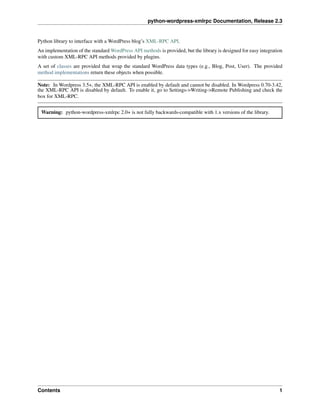
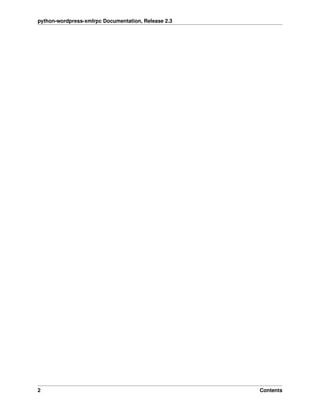
![CHAPTER 1
Getting Started
1.1 Overview
1.1.1 Installation
1. Verify you meet the following requirements:
• WordPress 3.4+ OR WordPress 3.0-3.3 with the XML-RPC Modernization Plugin.
• Python 2.6+ OR Python 3.x
2. Install from PyPI using easy_install python-wordpress-xmlrpc or pip install
python-wordpress-xmlrpc.
1.1.2 Quick Start
Create an instance of the Client class with the URL of the WordPress XML-RPC endpoint and user credentials.
Then pass an XmlrpcMethod object into its call method to execute the remote call and return the result.
>>> from wordpress_xmlrpc import Client, WordPressPost
>>> from wordpress_xmlrpc.methods.posts import GetPosts, NewPost
>>> from wordpress_xmlrpc.methods.users import GetUserInfo
>>> wp = Client('http://mysite.wordpress.com/xmlrpc.php', 'username', 'password')
>>> wp.call(GetPosts())
[<WordPressPost: hello-world (id=1)>]
>>> wp.call(GetUserInfo())
<WordPressUser: max>
>>> post = WordPressPost()
>>> post.title = 'My new title'
>>> post.content = 'This is the body of my new post.'
>>> post.terms_names = {
>>> 'post_tag': ['test', 'firstpost'],
>>> 'category': ['Introductions', 'Tests']
>>> }
>>> wp.call(NewPost(post))
5
Notice that properties of WordPress objects are accessed directly, and not through the definition attribute
defined in the source code.
3](https://image.slidesharecdn.com/python-wordpress-xmlrpc-170213080659/85/Python-wordpress-xmlrpc-7-320.jpg)
![python-wordpress-xmlrpc Documentation, Release 2.3
When a WordPress object is used as a method parameter, its struct parameter is automatically extracted for con-
sumption by XML-RPC. However, if you use an object in a list or other embedded data structure used as a parameter,
be sure to use obj.struct or else WordPress will not receive data in the format it expects.
Custom XML-RPC Methods
To interface with a non-standard XML-RPC method (such as one added by a plugin), you must sim-
ply extend wordpress_xmlrpc.XmlrpcMethod or one of its subclasses (AnonymousMethod or
AuthenticatedMethod).
The XmlrpcMethod class provides a number of properties which you can override to modify the behavior of the
method call.
Sample class to call a custom method added by a ficticious plugin:
from wordpress_xmlrpc import AuthenticatedMethod
class MyCustomMethod(AuthenticatedMethod):
method_name = 'custom.MyMethod'
method_args = ('arg1', 'arg2')
See Custom XML-RPC Methods for more details.
1.2 Examples
1.2.1 Working with Posts
python-wordpress-xmlrpc supports all registered WordPress post types.
Behind the scenes in WordPress, all post types are based on a single “post” database table, and all of the functionality
is exposed through the posts methods in the XML-RPC API.
For consistency, the same approach is adopted by python-wordpress-xmlrpc.
Note: Posts will be sent as drafts by default. If you want to publish a post, set post.post_status = ‘publish’.
Normal Posts
First, let’s see how to retrieve normal WordPress posts:
from wordpress_xmlrpc import Client
from wordpress_xmlrpc.methods import posts
client = Client(...)
posts = client.call(posts.GetPosts())
# posts == [WordPressPost, WordPressPost, ...]
And here’s how to create and edit a new post:
from wordpress_xmlrpc import WordPressPost
post = WordPressPost()
post.title = 'My post'
post.content = 'This is a wonderful blog post about XML-RPC.'
4 Chapter 1. Getting Started](https://image.slidesharecdn.com/python-wordpress-xmlrpc-170213080659/85/Python-wordpress-xmlrpc-8-320.jpg)
![python-wordpress-xmlrpc Documentation, Release 2.3
post.id = client.call(posts.NewPost(post))
# whoops, I forgot to publish it!
post.post_status = 'publish'
client.call(posts.EditPost(post.id, post))
Pages
Out of the box, WordPress supports a post type called “page” for static non-blog pages on a WordPress site. Let’s see
how to do the same actions for pages:
from wordpress_xmlrpc import WordPressPage
pages = client.call(posts.GetPosts({'post_type': 'page'}, results_class=WordPressPage))
# pages == [WordPressPage, WordPressPage, ...]
Note two important differences:
1. The filter parameter’s post_type option is used to limit the query to objects of the desired post type.
2. The constructor was passd a results_class keyword argument that told it what class to use to interpret the
response values.
And here’s how to create and edit a page:
page = WordPressPage()
page.title = 'About Me'
page.content = 'I am an aspiring WordPress and Python developer.'
page.post_status = 'publish'
page.id = client.call(posts.NewPost(page))
# no longer aspiring
page.content = 'I am a WordPress and Python developer.'
client.call(posts.EditPost(page.id, page))
Custom Post Types
While the pages example used its own results_class, that was a unique situation because pages are special in
WordPress and have fields directly in the posts table.
Most custom post types instead use post custom fields to store their additional information, and custom fields are
already exposed on WordPressPost.
For this example, let’s assume that your plugin or theme has added an acme_product custom post type to Word-
Press:
# first, let's find some products
products = client.call(posts.GetPosts({'post_type': 'acme_product', 'number': 100}))
# calculate the average price of these 100 widgets
sum = 0
for product in products:
# note: product is a WordPressPost object
for custom_field in product.custom_fields:
if custom_field['key'] == 'price':
sum = sum + custom_field['value']
break
1.2. Examples 5](https://image.slidesharecdn.com/python-wordpress-xmlrpc-170213080659/85/Python-wordpress-xmlrpc-9-320.jpg)
![python-wordpress-xmlrpc Documentation, Release 2.3
average = sum / len(products)
# now let's create a new product
widget = WordPressPost()
widget.post_type = 'acme_product'
widget.title = 'Widget'
widget.content = 'This is the widget's description.'
widget.custom_fields = []
widget.custom_fields.append({
'key': 'price',
'value': 2
})
widget.id = client.call(posts.NewPost(widget))
Advanced Querying
By default, wordpress_xmlrpc.methods.posts.GetPosts returns 10 posts in reverse-chronological order
(based on their publish date). However, using the filter parameter, posts can be queried in other ways.
Result Paging
If you want to iterate through all posts in a WordPress blog, a server-friendly technique is to use result paging using
the number and offset options:
# get pages in batches of 20
offset = 0
increment = 20
while True:
posts = client.call(posts.GetPosts({'number': increment, 'offset': offset}))
if len(posts) == 0:
break # no more posts returned
for post in posts:
do_something(post)
offset = offset + increment
Ordering
If you don’t want posts sorted by post_date, then you can use orderby and order options to change that
behavior.
For example, in sync scenarios you might want to look for posts by modification date instead of publish date:
recently_modified = client.call(posts.GetPosts({'orderby': 'post_modified', 'number': 100}))
Or if you want your ACME products sorted alphabetically:
products = client.call(posts.GetPosts({'post_type': 'acme_product', 'orderby': 'title', 'order': 'ASC
Post Status
Another common scenario is that you only want published posts:
6 Chapter 1. Getting Started](https://image.slidesharecdn.com/python-wordpress-xmlrpc-170213080659/85/Python-wordpress-xmlrpc-10-320.jpg)
![python-wordpress-xmlrpc Documentation, Release 2.3
published_posts = client.call(posts.GetPosts({'post_status': 'publish'}))
Or only draft posts:
draft_posts = client.call(posts.GetPosts({'post_status': 'draft'}))
You can find the set of valid post_status by using the wordpress_xmlrpc.methods.posts.GetPostStatusList
method.
1.2.2 Working with Taxonomies
Taxonomies in WordPress are a means of classifying content. Out of the box, WordPress has two primary taxonomies,
categories (category) and tags (post_tag). Plugins and themes can specify additional custom taxonomies.
Taxonomies
To retrieve a list of taxonomies for a WordPress blog, use wordpress_xmlrpc.methods.taxonomies.GetTaxonomies:
from wordpress_xmlrpc import Client
from wordpress_xmlrpc.methods import taxonomies
client = Client(...)
taxes = client.call(taxonomies.GetTaxonomies())
# taxes == [WordPressTaxonomy, WordPressTaxonomy, ...]
An individual taxonomy can be retrieved by name:
category_tax = client.call(taxonomies.GetTaxonomy('category'))
Note: Taxonomies can only be created and modified within WordPress using hooks in plugins or themes. The
XML-RPC API permits only reading of taxonomy metadata.
Terms
Terms are the individual entries in a taxonomy.
For example, to retrieve all blog categories:
categories = client.call(taxonomies.GetTerms('category'))
And to create a new tag:
from wordpress_xmlrpc import WordPressTerm
tag = WordPressTerm()
tag.taxonomy = 'post_tag'
tag.name = 'My New Tag'
tag.id = client.call(taxonomies.NewTerm(tag))
Or to create a child category:
parent_cat = client.call(taxonomies.GetTerm('category', 3))
child_cat = WordPressTerm()
child_cat.taxonomy = 'category'
1.2. Examples 7](https://image.slidesharecdn.com/python-wordpress-xmlrpc-170213080659/85/Python-wordpress-xmlrpc-11-320.jpg)
![python-wordpress-xmlrpc Documentation, Release 2.3
child_cat.parent = parent_cat.id
child_cat.name = 'My Child Category'
child_cat.id = client.call(taxonomies.NewTerm(child_cat))
Terms and Posts
Terms are of little use on their own, they must actually be assigned to posts.
If you already have WordPressTerm objects, use terms property of WordPressPost:
tags = client.call(taxonomies.GetTerms('post_tag', {...}))
post = WordPressPost()
post.title = 'Post with Tags'
post.content = '...'
post.terms = tags
post.id = client.call(posts.NewPost(post))
If you want to add a category to an existing post:
category = client.call(taxonomies.GetTerm('category', 3))
post = client.call(posts.GetPost(5))
post.terms.append(category)
client.call(posts.EditPost(post.id, post))
But what if you have not yet retrieved the terms or want to create new terms? For that, you can use the terms_names
property of WordPressPost:
post = WordPressPost()
post.title = 'Post with new tags'
post.content = '...'
post.terms_names = {
'post_tag': ['tagA', 'another tag'],
'category': ['My Child Category'],
}
post.id = client.call(posts.NewPost(post))
Note that terms_names is a dictionary with taxonomy names as keys and list of strings as values. WordPress
will look for existing terms with these names or else create new ones. Be careful with hierarchical taxonomies like
category because of potential name ambiguities (multiple terms can have the same name if they have different
parents); if WordPress detects ambiguity, it will throw an error and ask that you use terms instead with a proper
WordPressTerm.
Advanced Querying
By Count
To find the 20 most-used tags:
tags = client.call(taxonomies.GetTerms('post_tag', {'number': 20, 'orderby': 'count', 'order': 'DESC'
for tag in tags:
print tag.name, tag.count
8 Chapter 1. Getting Started](https://image.slidesharecdn.com/python-wordpress-xmlrpc-170213080659/85/Python-wordpress-xmlrpc-12-320.jpg)
![python-wordpress-xmlrpc Documentation, Release 2.3
Searching/Autocomplete
To perform case-insensitive searching against term names, use the search option for filter:
user_input = 'wor' # e.g., from UI textbox
tags = client.call(taxonomies.GetTerms('post_tag', {'search': user_input, 'orderby': 'count', 'number
suggestions = [tag.name for tag in tags]
# suggestions == ['word', 'WordPress', 'world']
1.2.3 Working with Media
Uploading a File
The wordpress_xmlrpc.methods.media.UploadFile method can be used to upload new files to a Word-
Press blog:
from wordpress_xmlrpc import Client, WordPressPost
from wordpress_xmlrpc.compat import xmlrpc_client
from wordpress_xmlrpc.methods import media, posts
client = Client(...)
# set to the path to your file
filename = '/path/to/my/picture.jpg'
# prepare metadata
data = {
'name': 'picture.jpg',
'type': 'image/jpeg', # mimetype
}
# read the binary file and let the XMLRPC library encode it into base64
with open(filename, 'rb') as img:
data['bits'] = xmlrpc_client.Binary(img.read())
response = client.call(media.UploadFile(data))
# response == {
# 'id': 6,
# 'file': 'picture.jpg'
# 'url': 'http://www.example.com/wp-content/uploads/2012/04/16/picture.jpg',
# 'type': 'image/jpeg',
# }
attachment_id = response['id']
This newly-uploaded attachment can then be set as the thumbnail for a post:
post = WordPressPost()
post.title = 'Picture of the Day'
post.content = 'What a lovely picture today!'
post.post_status = 'publish'
post.thumbnail = attachment_id
post.id = client.call(posts.NewPost(post))
Note: If you do not know the mimetype at development time, you can use the mimetypes library in Python:
1.2. Examples 9](https://image.slidesharecdn.com/python-wordpress-xmlrpc-170213080659/85/Python-wordpress-xmlrpc-13-320.jpg)
![python-wordpress-xmlrpc Documentation, Release 2.3
data['type'] = mimetypes.read_mime_types(filename) or mimetypes.guess_type(filename)[0]
Querying
Use wordpress_xmlrpc.methods.media.GetMediaLibrary and wordpress_xmlrpc.methods.media.GetMedia
to retrieve information about attachments.
1.2.4 Custom XML-RPC Methods
See the WordPress Codex for details on how to write a WordPress plugin that adds custom XML-RPC method to
WordPress.
The following examples will use the sample methods from that codex page.
Anonymous Methods
To use the mynamespace.subtractTwoNumbers method, create a class derived from
wordpress_xmlrpc.AnonymousMethod:
from wordpress_xmlrpc import AnonymousMethod
class SubtractTwoNumbers(AnonymousMethod):
method_name = 'mynamespace.subtractTwoNumbers'
method_args = ('number1', 'number2')
This class can then be used with Client.call():
from wordpress_xmlrpc import Client
client = Client('http://www.example.com/xmlrpc.php', 'harrietsmith', 'mypassword')
difference = client.call(SubtractTwoNumbers(10, 5))
# difference == 5
Authenticated Methods
If your custom authenticated method follows the common method(blog_id, username, password,
*args) structure, then you can use wordpress_xmlrpc.AuthenticatedMethod:
from wordpress_xmlrpc import AuthenticatedMethod
class GetUserID(AuthenticatedMethod):
method_name = 'mynamespace.getUserID'
Again, this class can then be used with Client.call():
user_id = client.call(GetUserID())
# user_id == 3
Note that you do not have to supply blog_id, username, or password to the class constructor, since these
are automatically added by AuthenticatedMethod. Custom method classes only require arguments specified by
method_args and the optional optional_args.
10 Chapter 1. Getting Started](https://image.slidesharecdn.com/python-wordpress-xmlrpc-170213080659/85/Python-wordpress-xmlrpc-14-320.jpg)
![CHAPTER 2
Reference
2.1 Client
The Client class is the gateway to your WordPress blog’s XML-RPC interface.
Once initialized with your blog URL and user credentials, the client object is ready to execute XML-RPC methods
against your WordPress blog using its Client.call() method.
2.1.1 Client
class Client(url, username, password[, blog_id, transport ])
Parameters
• url – URL of the blog’s XML-RPC endpoint (e.g., http://www.example.com/xmlrpc.php)
• username – Username of a valid user account on the WordPress blog
• password – The password for this user account
• blog_id – The blog’s ID (note: WordPress ignores this value, but it is retained for back-
wards compatibility)
• transport – Custom XML-RPC transport implementation. See Python2 or Python3 doc-
umentation.
call(method)
Parameters method – wordpress_xmlrpc.XmlrpcMethod-derived class
2.1.2 XML-RPC Method Classes
Library to interface with the WordPress XML-RPC API.
See README for usage instructions.
class wordpress_xmlrpc.XmlrpcMethod
Base class for XML-RPC methods.
Child classes can override methods and properties to customize behavior:
Properties:
• method_name: XML-RPC method name (e.g., ‘wp.getUserInfo’)
11](https://image.slidesharecdn.com/python-wordpress-xmlrpc-170213080659/85/Python-wordpress-xmlrpc-15-320.jpg)
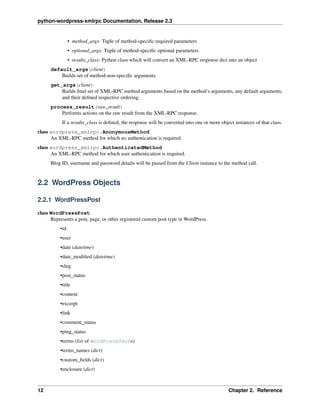
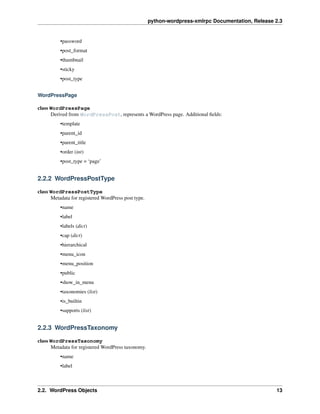

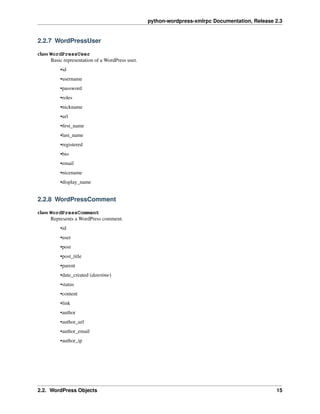
![python-wordpress-xmlrpc Documentation, Release 2.3
2.2.9 WordPressMedia
class WordPressMedia
Represents a WordPress post media attachment.
•id
•parent
•title
•description
•caption
•date_created (datetime)
•link
•thumbnail
•metadata
2.2.10 WordPressOption
class WordPressOption
Represents a WordPress blog setting/option.
•name
•description
•value
•read_only (bool)
2.3 Methods
See Examples for guidance on how to use the following method classes.
2.3.1 methods.posts
class wordpress_xmlrpc.methods.posts.GetPosts([filter, fields])
Retrieve posts from the blog.
Parameters:
filter: optional dict of filters:
• number
• offset
• orderby
• order: ‘ASC’ or ‘DESC’
• post_type: Defaults to ‘post’
• post_status
16 Chapter 2. Reference](https://image.slidesharecdn.com/python-wordpress-xmlrpc-170213080659/85/Python-wordpress-xmlrpc-20-320.jpg)
![python-wordpress-xmlrpc Documentation, Release 2.3
Returns: list of WordPressPost instances.
class wordpress_xmlrpc.methods.posts.GetPost(post_id[, fields])
Retrieve an individual blog post.
Parameters: post_id: ID of the blog post to retrieve.
Returns: WordPressPost instance.
class wordpress_xmlrpc.methods.posts.NewPost(content)
Create a new post on the blog.
Parameters: content: A WordPressPost instance with at least the title and content values set.
Returns: ID of the newly-created blog post (an integer).
class wordpress_xmlrpc.methods.posts.EditPost(post_id, content)
Edit an existing blog post.
Parameters: post_id: ID of the blog post to edit. content: A WordPressPost instance with the new values
for the blog post.
Returns: True on successful edit.
class wordpress_xmlrpc.methods.posts.DeletePost(post_id)
Delete a blog post.
Parameters: post_id: ID of the blog post to delete.
Returns: True on successful deletion.
class wordpress_xmlrpc.methods.posts.GetPostStatusList
Retrieve the set of possible blog post statuses (e.g., “draft,” “private,” “publish”).
Parameters: None
Returns: dict of values and their pretty names.
Example:
>>> client.call(GetPostStatusList())
{'draft': 'Draft', 'private': 'Private', 'pending': 'Pending Review', 'publish': 'Published'
class wordpress_xmlrpc.methods.posts.GetPostFormats
Retrieve the set of post formats used by the blog.
Parameters: None
Returns: dict containing a dict of all blog post formats (all) and a list of formats supported by the theme.
Example:
>>> client.call(GetPostFormats())
{'all': {'status': 'Status', 'quote': 'Quote', 'image': 'Image', 'aside': 'Aside', 'standard
'supported': ['aside', 'link', 'gallery', 'status', 'quote', 'image']}
class wordpress_xmlrpc.methods.posts.GetPostTypes
Retrieve a list of post types used by the blog.
Parameters: None
Returns: dict with names as keys and WordPressPostType instances as values.
class wordpress_xmlrpc.methods.posts.GetPostType(post_type)
Retrieve an individual blog post type.
Parameters: post_type: Name of the blog post type to retrieve.
2.3. Methods 17](https://image.slidesharecdn.com/python-wordpress-xmlrpc-170213080659/85/Python-wordpress-xmlrpc-21-320.jpg)
![python-wordpress-xmlrpc Documentation, Release 2.3
Returns: WordPressPostType instance.
2.3.2 methods.pages
class wordpress_xmlrpc.methods.pages.GetPageStatusList
Retrieve the set of possible blog page statuses (e.g., “draft,” “private,” “publish”).
Parameters: None
Returns: dict of values and their pretty names.
Example:
>>> client.call(GetPageStatusList())
{'draft': 'Draft', 'private': 'Private', 'publish': 'Published'}
class wordpress_xmlrpc.methods.pages.GetPageTemplates
Retrieve the list of blog templates.
Parameters: None
Returns: dict of values and their paths.
Example:
>>> client.call(GetPageTemplates())
{'Default': 'default', 'Sidebar Template': 'sidebar-page.php', 'Showcase Template': 'showcas
2.3.3 methods.taxonomies
class wordpress_xmlrpc.methods.taxonomies.GetTaxonomies
Retrieve the list of available taxonomies for the blog.
Parameters: None
Returns: list of WordPressTaxonomy instances.
class wordpress_xmlrpc.methods.taxonomies.GetTaxonomy(taxonomy)
Retrieve an individual taxonomy.
Parameters: taxonomy: name of the taxonomy
Returns: WordPressTaxonomy instance.
class wordpress_xmlrpc.methods.taxonomies.GetTerms(taxonomy[, filter ])
Retrieve the list of available terms for a taxonomy.
Parameters: taxonomy: name of the taxonomy
filter: optional dict of filters:
• number
• offset
• orderby
• order: ‘ASC’ or ‘DESC’
• hide_empty: Whether to return terms with count==0
• search: Case-insensitive search on term names
Returns: list of WordPressTerm instances.
18 Chapter 2. Reference](https://image.slidesharecdn.com/python-wordpress-xmlrpc-170213080659/85/Python-wordpress-xmlrpc-22-320.jpg)
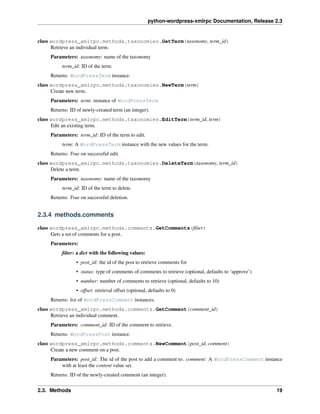
![python-wordpress-xmlrpc Documentation, Release 2.3
class wordpress_xmlrpc.methods.comments.NewAnonymousComment(post_id, comment)
Create a new comment on a post without authenticating.
NOTE: Requires support on the blog by setting the following filter in a plugin or theme:
add_filter( ‘xmlrpc_allow_anonymous_comments’, ‘__return_true’ );
Parameters: post_id: The id of the post to add a comment to. comment: A WordPressComment instance
with at least the content value set.
Returns: ID of the newly-created comment (an integer).
class wordpress_xmlrpc.methods.comments.EditComment(comment_id, comment)
Edit an existing comment.
Parameters: comment_id: The id of the comment to edit. comment: A WordPressComment instance with
at least the content value set.
Returns: True on successful edit.
class wordpress_xmlrpc.methods.comments.DeleteComment(comment_id)
Delete an existing comment.
Parameters: comment_id: The id of the comment to be deleted.
Returns: True on successful deletion.
class wordpress_xmlrpc.methods.comments.GetCommentStatusList
Retrieve the set of possible blog comment statuses (e.g., “approve,” “hold,” “spam”).
Parameters: None
Returns: dict of values and their pretty names.
Example:
>>> client.call(GetCommentStatusList())
{'hold': 'Unapproved', 'approve': 'Approved', 'spam': 'Spam'}
class wordpress_xmlrpc.methods.comments.GetCommentCount(post_id)
Retrieve comment count for a specific post.
Parameters: post_id: The id of the post to retrieve comment count for.
Returns: dict of comment counts for the post divided by comment status.
Example:
>>> client.call(GetCommentCount(1))
{'awaiting_moderation': '2', 'total_comments': 23, 'approved': '18', 'spam': 3}
2.3.5 methods.users
class wordpress_xmlrpc.methods.users.GetUser(user_id[, fields])
Retrieve an individual user.
Parameters: user_id: ID of the user fields: (optional) list of fields to return. Specific fields, or groups ‘basic’
or ‘all’.
Returns: WordPressUser instance.
class wordpress_xmlrpc.methods.users.GetUsers([filter, fields])
Retrieve list of users in the blog.
20 Chapter 2. Reference](https://image.slidesharecdn.com/python-wordpress-xmlrpc-170213080659/85/Python-wordpress-xmlrpc-24-320.jpg)
![python-wordpress-xmlrpc Documentation, Release 2.3
Parameters:
filter: optional dict of filters:
• number
• offset
• role
fields: optional list of fields to return. Specific fields, or groups ‘basic’ or ‘all’.
Returns: list of WordPressUser instances.
class wordpress_xmlrpc.methods.users.GetProfile
Retrieve information about the connected user.
Parameters: None
Returns: instance of WordPressUser representing the user whose credentials are being used with the XML-
RPC API.
class wordpress_xmlrpc.methods.users.EditProfile(user)
Edit profile fields of the connected user.
Parameters: user: WordPressUser instance.
Returns: True on successful edit.
class wordpress_xmlrpc.methods.users.GetUsersBlogs
Retrieve list of blogs that this user belongs to.
Parameters: None
Returns: list of WordPressBlog instances.
class wordpress_xmlrpc.methods.users.GetAuthors
Retrieve list of authors in the blog.
Parameters: None
Returns: list of WordPressAuthor instances.
2.3.6 methods.media
class wordpress_xmlrpc.methods.media.GetMediaLibrary([filter ])
Retrieve filtered list of media library items.
Parameters:
filter: dict with optional keys:
• number: number of media items to retrieve
• offset: query offset
• parent_id: ID of post the media item is attached to. Use empty string (default) to show all me-
dia items. Use 0 to show unattached media items.
• mime_type: file mime-type to filter by (e.g., ‘image/jpeg’)
Returns: list of WordPressMedia instances.
class wordpress_xmlrpc.methods.media.GetMediaItem(attachmend_id)
Retrieve an individual media item.
2.3. Methods 21](https://image.slidesharecdn.com/python-wordpress-xmlrpc-170213080659/85/Python-wordpress-xmlrpc-25-320.jpg)




